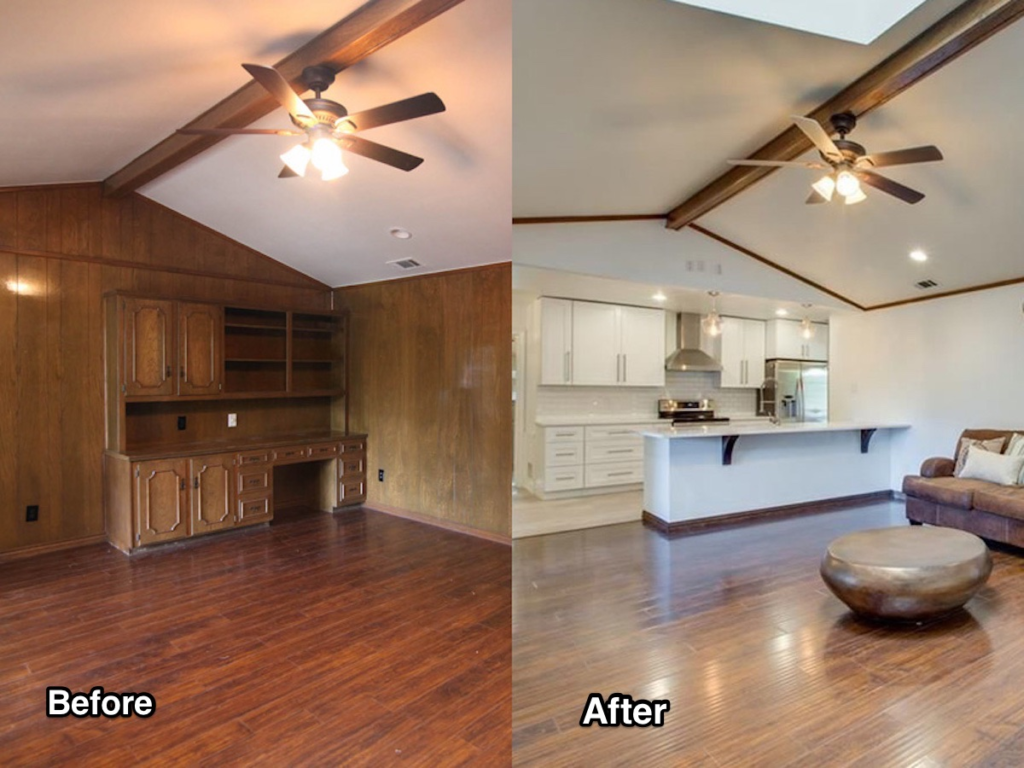Property flipping is a dynamic project that involves purchasing properties to quickly resell them for a profit. Understanding the details of property flipping can pave the way for profitable opportunities in the real estate market. Let’s research the distinctions of property flipping and explore the essential elements in this captivating realm.
Understanding the Concept of Property Flipping
Property flipping means buying distressed properties at low prices, renovating them, and reselling them at higher prices for profit. It requires market knowledge, strategic planning, and effective execution for successful returns.
The History of Property Flipping
The act of property flipping dates back to ancient civilizations, when people would purchase and sell properties to make a profit. In contemporary times, property flipping has become increasingly popular during periods of economic growth and housing booms. This practice has been refined with the help of technological advancements and changes in market dynamics.
Key Benefits of Property Flipping
1. Profit Potential: Property flipping offers the opportunity to generate large profits within relatively short timeframes.
2. Creative Expression: Flipping houses allows individuals to release creativity through property renovations and design enhancements.
3. Market Participation: Engaging in property flipping enables individuals to actively participate in the real estate market and capitalize on emerging trends.
The Basics of Flipping Houses
House flipping involves purchasing residential properties, renovating them, and selling them for a profit. This process demands careful planning, efficient project management, and a keen eye for market trends.
Types of Properties Suitable for Flipping
Flipping properties can be done with various property types, such as single-family homes, condominiums, townhouses, and distressed properties. Each type of property has its own unique opportunities and challenges for those who want to flip them.
Market Considerations for House Flipping
Understanding local market conditions, supply and demand dynamics, and demographic trends is crucial for identifying lucrative flipping opportunities. Conducting thorough market research empowers flippers to make informed decisions and mitigate risks.
Legal and Regulatory Aspects of House Flipping
Navigating legal and regulatory requirements is paramount in the realm of property flipping. Compliance with zoning regulations, building codes, and contractual obligations ensures a smooth and legally sound flipping process.
Getting Started in Real Estate Flipping
Assessing Your Financial Situation
Before embarking on a property-flipping project, assess your financial resources, including savings, investments, and access to financing options. Establishing a clear understanding of your financial standing sets the foundation for successful flipping actions.
Creating a Realistic Budget for Flipping
Developing a comprehensive budget is essential for managing project expenses and maximizing profitability. Factor in costs related to property acquisition, renovation materials, labor, permits, and contingencies to create a realistic financial framework.
Building Your Real Estate Flipping Team
Collaborating with a team of experts, including real estate agents, contractors, architects, and legal advisors, is crucial for executing successful flipping projects. This enhances efficiency, minimizes risks, and fosters optimal outcomes.
Finding Profitable Properties to Flip
Identifying workable properties for flipping requires a blend of market insight, research prowess, and networking capabilities. Explore various channels, such as MLS listings, foreclosure auctions, real estate wholesalers, and direct marketing strategies, to uncover profitable opportunities.
Analyzing Properties for Flipping Potential
Understanding Property Value and Market Trends
Conduct thorough comparative market analyses (CMAs) and assess property values in target neighborhoods. Monitor market trends, including appreciation rates, inventory levels, and demand-supply dynamics, to identify properties with favorable flipping potential.
Key Factors to Consider When Evaluating a Property
Evaluate key factors such as location, condition, size, layout, facilities, and potential for value appreciation. Conduct property inspections, assess structural integrity, and identify renovation needs to make informed investment decisions.
Identifying Renovation Opportunities and Costs
Identify renovation opportunities that align with market preferences and buyer expectations. Estimate renovation costs accurately, considering labor expenses, materials, permits, and unforeseen contingencies, to formulate a comprehensive budget.

Calculating Potential Profit Margins
Project potential profit margins by analyzing acquisition costs, renovation expenses, carrying costs, and anticipated selling prices. Factor in market fluctuations, financing costs, and transaction fees to assess the feasibility and profitability of flipping endeavors.
Financing Options for Flipping Houses
Traditional Mortgage Loans
Traditional mortgage loans from banks and lending institutions offer competitive interest rates and terms for qualified mortgagors. Secure pre-approval to streamline the property acquisition process and gain a competitive edge in competitive markets.
Hard Money Loans
Hard money loans provide flexible financing solutions for property-flipping projects, catering to investors with less-than-perfect credit or unusual financial profiles. Explore hard money lending options tailored to your specific needs and project requirements.
Private Investors and Partnerships
Forming strategic partnerships with private investors, equity partners, or joint venture entities can provide access to capital, expertise, and resources for ambitious flipping endeavors. Negotiate mutually beneficial terms and establish clear expectations to foster successful collaborations.
Creative Financing Strategies
Explore creative financing strategies, such as seller financing, lease options, and subject-to-transactions, to acquire properties with minimal upfront capital. Leverage seller concessions, seller carryback financing, and creative negotiation tactics to structure favorable deals.
Executing the Flipping Process
Developing a Flipping Timeline and Schedule
Create a comprehensive timeline and project schedule outlining key milestones, deadlines, and deliverables for each phase of the flipping process. Implement efficient project management practices to optimize workflow and minimize downtime.
Managing Renovation Projects Effectively
Coordinate renovation projects effectively by hiring reputable contractors, obtaining necessary permits, and adhering to project timelines and budgets. Communicate clearly with contractors, oversee quality control measures, and address any issues promptly to ensure project success.
Anticipate and address common challenges and obstacles met during the flipping process, such as unforeseen repairs, budget overruns, permitting delays, and market fluctuations. Maintain flexibility, adaptability, and a problem-solving mindset to overcome obstacles and stay on course.
Maximizing Property Value through Smart Design Choices
Incorporate strategic design elements and value-added features to enhance property appeal and maximize market value. Focus on high-impact upgrades, such as kitchen remodels, bathroom renovations, curb appeal enhancements, and energy-efficient improvements, to attract discerning buyers.
Marketing and Selling Flipped Properties
Creating Compelling Property Listings
Craft compelling property listings that highlight key selling points, features, and amenities to capture buyer interest and drive engagement. Use professional photography, virtual tours, and descriptive language to showcase properties in their best light.
Utilizing Digital Marketing Strategies
Harness the power of digital marketing channels, including websites, social media platforms, email campaigns, and online advertising, to reach a broader audience of prospective buyers. Implement targeted marketing strategies tailored to specific buyer demographics and preferences.
Staging and Presenting Properties for Sale
Stage properties effectively to create inviting and visually appealing environments that resonate with buyers. Declutter spaces, depersonalize décor and emphasize functionality and lifestyle appeal to help buyers envision themselves living in the space.
Negotiating Offers and Closing Deals
Navigate negotiations skillfully by leveraging market data, assessing buyer motivations, and advocating for your interests as a seller. Collaborate with experienced real estate agents and legal advisors to negotiate favorable terms, mitigate risks, and facilitate seamless transactions.
Mitigating Risks in Property Flipping
Understanding Potential Risks and Pitfalls
Identify and evaluate potential risks and pitfalls associated with property flipping, including
market volatility, economic downturns, regulatory changes, and unforeseen expenses. Conduct risk assessments regularly and implement proactive strategies to mitigate potential threats.
Implementing Risk Management Strategies
Implement risk management strategies, such as diversifying investment portfolios, maintaining adequate reserves, and securing insurance coverage, to safeguard against potential losses and liabilities. Stay informed about market trends, regulatory developments, and industry best practices to adapt to changing conditions.
Building Contingency Plans for Unforeseen Circumstances
In order to ensure the success of flipping projects, it’s essential to develop and implement contingency plans that can effectively address any unforeseen circumstances, emergencies, or disruptions that may arise. These plans should take into account any potential worst-case scenarios, and establish backup options to maintain project momentum in the event of any disruptions. Additionally, clear and open communication channels must be established with all stakeholders to ensure that everyone is aware of the contingency plans and can work together to mitigate any potential disruptions. With these measures in place, the likelihood of successful completion of the flipping project is greatly increased.
Scaling Your Property Flipping Business
Expanding Your Portfolio of Flipped Properties
Explore opportunities to expand your portfolio of flipped properties by identifying new markets, diversifying property types, and pursuing strategic acquisitions. Continuously assess market trends, investment opportunities, and emerging growth areas to capitalize on evolving market dynamics.
Building Long-Term Relationships in the Real Estate Industry
Cultivate long-term relationships with industry professionals, including real estate agents, contractors, lenders, and investors, to foster collaboration, exchange insights, and access valuable resources. Invest in networking opportunities, participate in industry events, and contribute to professional communities to build credibility and trust.
Exploring Opportunities for Passive Income and Investment Growth
Diversify your investment strategy by exploring opportunities for passive income and investment growth, such as rental properties, real estate investment trusts (REITs), and syndication deals. Evaluate potential investment vehicles based on risk tolerance, financial objectives, and market conditions to optimize returns and portfolio performance.
What are some common mistakes to avoid when flipping houses?
Flipping houses can be a lucrative venture, but it also comes with its fair share of challenges and risks. Avoiding common mistakes is crucial to the success of a flipping project. Here are some of the most common mistakes to avoid when flipping houses:
- Underestimating Costs: Failing to accurately estimate renovation costs, carrying costs, and other expenses can quickly erode potential profits. It’s essential to conduct thorough research, obtain multiple quotes from contractors, and factor in contingencies to ensure a realistic budget.
- Overlooking Due Diligence: Skipping proper due diligence, such as property inspections, title searches, and zoning regulations, can lead to unforeseen issues and legal complications down the line. Investing time and resources in comprehensive due diligence is vital to mitigating risks and making informed decisions.
- Overpaying for Properties: Overestimating the resale value of a property or overpaying during the acquisition phase can significantly impact profitability. Conducting thorough comparative market analyses (CMAs) and negotiating favorable purchase prices are critical steps in maximizing potential returns.
- Ignoring Market Trends: Failing to stay abreast of market trends, supply and demand dynamics, and local economic indicators can result in misjudging the viability of a flipping project. Understanding market conditions and buyer preferences is essential for identifying profitable opportunities and maximizing property value.
- Underestimating Time Constraints: Flipping houses often requires meticulous planning and project management to meet deadlines and avoid costly delays. Underestimating the time required for renovations, permitting processes, and marketing efforts can lead to extended holding periods and increased carrying costs.
- Over-Improving Properties: While renovations are essential for enhancing property value, over-improving or adding unnecessary upgrades can exceed market expectations and yield diminishing returns. Focus on cost-effective renovations that align with market demands and yield the highest return on investment (ROI).
- Neglecting Proper Financing: Securing appropriate financing options and managing cash flow effectively are critical aspects of successful house flipping. Relying solely on high-interest loans or inadequate funding sources can strain financial resources and impede project progress.
- Poor Project Management: Inadequate project management practices, including lack of communication, oversight, and coordination among team members, can lead to subpar results and project delays. Implementing efficient project management systems and fostering effective collaboration are essential for project success.
- Ignoring Legal and Regulatory Compliance: Neglecting legal and regulatory requirements, such as building codes, permits, and environmental regulations, can result in costly fines, penalties, and legal disputes. Ensuring full compliance with applicable laws and regulations is paramount for protecting investments and maintaining credibility.
- Overlooking Exit Strategies: Failing to devise contingency plans or alternative exit strategies in the event of market downturns or unforeseen circumstances can leave investors vulnerable to financial losses. Developing multiple exit strategies and diversifying investment portfolios can mitigate risks and enhance flexibility in challenging market conditions.
By avoiding these common mistakes and adopting sound investment practices, aspiring flippers can increase their chances of success and achieve favorable outcomes in the competitive world of house flipping.
What are some potential risks associated with property flipping?
Property flipping, while potentially lucrative, also comes with inherent risks that investors should be aware of. Understanding and mitigating these risks is crucial for successful flipping endeavors. Here are some potential risks associated with property flipping:
- Market Volatility: Fluctuations in the real estate market, including changes in property values, interest rates, and economic conditions, can impact the profitability of flipping projects. Market downturns or oversupply can lead to reduced demand and lower selling prices, affecting potential returns.
- Overleveraging: Relying heavily on borrowed funds or high levels of debt to finance flipping projects can increase financial risk, especially during periods of economic uncertainty or rising interest rates. Overleveraging can strain cash flow, limit flexibility, and expose investors to potential foreclosure or bankruptcy.
- Unexpected Repair Costs: Underestimating renovation costs or encountering unforeseen repair issues during the flipping process can erode profit margins and delay project timelines. Structural defects, code violations, and hidden damages may require costly repairs, impacting overall project profitability.
- Legal and Regulatory Compliance: Non-compliance with zoning regulations, building codes, permits, and environmental laws can result in fines, penalties, and legal disputes that jeopardize flipping projects. Failure to obtain necessary permits or address regulatory requirements can delay projects and incur additional expenses.
- Property Marketability: Flipping properties that lack market appeal or are located in undesirable neighborhoods may result in difficulty selling or attracting potential buyers. Factors such as property condition, location, amenities, and market demand influence property marketability and resale value.
- Cash Flow Constraints: Flipping projects require sufficient liquidity to cover acquisition costs, renovation expenses, carrying costs, and other operational expenses. Cash flow constraints or unexpected delays in project timelines can strain financial resources and impede project progress.
- Competition and Saturation: Intense competition in the real estate market and oversaturation of flipping activity in certain areas can limit profit margins and increase acquisition costs. Identifying untapped markets or niche opportunities is essential for mitigating competitive pressures and maximizing profitability.
- Unforeseen Market Trends: Rapid changes in consumer preferences, demographic shifts, and technological advancements can impact property demand and market trends. Failure to anticipate and adapt to evolving market dynamics may result in missed opportunities or reduced property values.
- Financing Challenges: Difficulty securing financing or accessing capital for flipping projects, especially for investors with limited credit history or unconventional financial profiles, can hinder project feasibility and expansion opportunities. Exploring alternative financing options and building strong relationships with lenders is essential for overcoming financing challenges.
- Lack of Experience and Expertise: Inexperienced flippers may underestimate the complexities of property flipping, including project management, market analysis, and risk assessment. Lack of expertise in areas such as property valuation, renovation planning, and negotiation strategies can increase the likelihood of costly mistakes and project setbacks.
By recognizing and proactively addressing these potential risks, investors can navigate the challenges of property flipping more effectively and position themselves for long-term success in the dynamic real estate market. Implementing sound risk management strategies, conducting thorough due diligence, and staying informed about market trends is essential for mitigating risks and maximizing returns in property-flipping ventures.
House Flipping Calculator
Before buying any distressed house must check its market value through different websites like Zillow, realtor, and Redfin as well as you can your house flipping calculator to check house value.
| Section | Description |
| Property Information | Address, Size, Condition, Asking Price |
| Acquisition Costs | Purchase Price, Closing Costs, Title Insurance, Transaction Fees |
| Renovation Budget | Materials, Labor, Permits, Contractor Fees, Other Renovation Expenses |
| Financing Details | Loan Amount, Interest Rate, Loan Term, Loan Fees |
| Carrying Costs | Property Taxes, Insurance, Utilities, HOA Fees, Maintenance Costs |
| Projected Selling Price | Estimated Selling Price Based on Comparable Sales |
| Selling Expenses | Real Estate Agent Commissions, Closing Costs, Transfer Taxes, Other Selling Expenses |
| Profit Analysis | Total Expenses (Acquisition, Renovation, Financing, Carrying, Selling) – Projected Selling Price |
| Return on Investment (ROI) | (Projected Profit / Total Investment Cost) x 100% |
| Break-Even Analysis | Minimum Selling Price Required to Cover All Expenses and Achieve Breakeven |
| Amortization Schedule | Breakdown of Loan Payments over Loan Term |
| Tax Implications | Estimate of Capital Gains Taxes and Other Tax Liabilities Associated with Sale |
| Sensitivity Analysis | Scenario Analysis to Assess Impact of Variable Changes on Potential Profits and ROI |
| Summary and Recommendations | Key Findings, Insights, and Recommendations Derived from Analysis |
Conclusion
In conclusion, property flipping offers a dynamic pathway to financial prosperity and entrepreneurial success in the real estate market. By understanding the fundamental principles of property flipping, navigating market dynamics, and executing strategic initiatives, aspiring flippers can unlock a world of opportunity and potential. Embrace the journey of property flipping with confidence, diligence, and a commitment to excellence, and watch your real estate aspirations come to fruition.
Recap of Key Points
– Property flipping involves buying, renovating, and selling properties for profit.
– Understanding market trends, financial considerations, and risk management is essential for successful flipping endeavors.
– Strategic planning, effective execution, and continuous learning are critical components of a thriving flipping business.
Encouragement to Take Action
Seize the opportunity to embark on your property-flipping journey with determination, resilience, and a willingness to learn and adapt. Embrace challenges as opportunities for growth, leverage your strengths, and stay focused on your long-term vision of success.
Closing Thoughts on the Future of Property Flipping
As the real estate market continues to evolve and adapt to changing consumer preferences and technological advancements, the future of property flipping remains bright and promising. By staying agile, innovative, and forward-thinking, flippers can capitalize on emerging trends, capitalize on new opportunities, and shape the future of the real estate industry. Embark on your flipping journey with confidence, passion, and a relentless pursuit of excellence, and let your entrepreneurial spirit soar.




